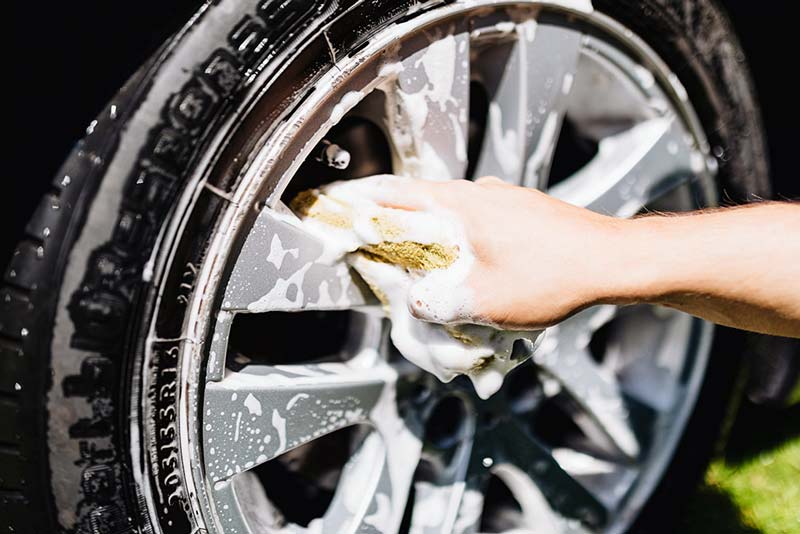RV tires are often overlooked until there’s a problem, but they’re one of the most important parts of staying safe on the road. Proper tire maintenance not only protects your RV and saves money in the long run, but it also helps you travel with confidence. Whether you’re a weekend camper or a full-time RVer, tire safety should always be a priority.
Why RV Tire Maintenance Matters
Good tires make for more comfortable trips, and they can help save on fuel costs. Tires that are over- or underinflated not only reduce gas mileage, but they can lead to serious hazards with deadly consequences. Tires that are overinflated can reduce traction, impact braking ability and make it harder to control an RV. When a tire is underinflated, it can cause structural damage to the tire and cost hundreds of dollars, if not $1,000 or more to replace.
“Let’s face it, RV tires take more abuse than standard car tires. They are often running at maximum load for long distances on hot highways, and they can often sit for months at a time without moving,” said Eric Johnson, owner of TechnoRV.
With proper care and attention to their age or condition, you can get a lot of mileage out of what is usually one of the biggest maintenance investments RVers need to make.
Best Practices to Extend RV Tire Life
Watch RV Weight and Speed
One of the best things RVers can do for their tires is to ensure they don’t carry more weight than they were designed to carry, and that tires don’t exceed their rated maximum speed.
Some trailer tires are designed for speeds less than 60 mph. Zooming around at 80 mph creates a dangerous situation. High speeds increase heat inside the tire, which works to weaken its structure and make it susceptible to a blowout.
Tires are also built to support a maximum weight, referred to as a load index. When too much weight rests on tires, that makes it difficult for them to operate at peak efficiency. Eventually, the tire will scream “uncle,” and break apart. Overweight RVs can also impact the effectiveness and longevity of chassis springs and shock absorbers.
When weighing the RV, be sure to have each tire tested to ensure that no one tire is carrying more weight than it is designed to bear.

When to Change RV Tires
For most RVers, tires will need to be changed long before the tread wears out. Most Workampers drive their RV to a job location, park it for three to six months and then move to a different place. While the average automobile is driven between 13,000 and 14,000 miles a year, it is unusual that a Workamper would put on more than 6,000 miles on an RV during that time.
The No. 1 issue impacting RV tires is time, not mileage. Every tire has an age or “born on” date stamped inside an oval on the sidewall. The number starts with DOT and ends in four digits. Those ending digits indicate when the tire was manufactured. For example, if it says “3519,” that means it was made during the 35th week of 2019.
Many RV tires could continue to work well for 250,000 miles, but the rubber will only last five to seven years before it breaks down and starts to crack, Johnson said. Ultraviolet rays and constant exposure to sun can cause rubber to crack. Cracked tires makes for weak tires, which can lead to blowouts. Blowouts rarely happen at convenient locations.
Another common issue involves the beads working to keep a tire balanced as it rotates, explained Jeff Brown, owner of RVTires.com, during a 2020 podcast interview.
“A tire changes as it ages. It’s not the same tire, whether it is two years or six years after it is installed,” he said. “It needs to be changed anyway because, as it ages, the tire changes and the little ceramic beads about the size of a head of a pencil roll around inside the tire and eventually wear out.”
Many Workampers check the condition of their tires every time they fill up with gas or stop at a rest area. That helps to identify inflation concerns and other issues that may require attention, if not replacement of a tire.
But, regardless of how much tread remains on a tire, RV tires should be replaced within seven years of the date they were manufactured.
Common RV Tire Mistakes to Avoid
Old RV Tires Sold as New
One problem that seems to plague some RVers involves buying a new recreational vehicle with tires that are already old. RV manufacturers can often get better deals when they buy tires in bulk. Yet, the tires may sit in storage for a year or two before they are actually installed on an RV.
For example, someone buying a 2023 motorhome may think the tires were manufactured this year, too. But, when checking the DOT code on the sidewall, they’ll discover the tire may have been made several years earlier. Be sure to check the DOT codes on the tires when an RV is picked up to ensure new tires weren’t replaced with older ones in a switcheroo.
The DOT tire code is imprinted on only one side of a tire. Honest installers will always ensure the code is visible on the outside of the tire. Unscrupulous installers will mount tires so the DOT code faces inside where it can’t be readily verified.
RV manufacturers also tend to install less expensive tires imported from overseas manufacturers. This is a cost-saving measure to help keep prices down. But, imported tires have been known to blow out more easily. For that reason, many full-time RVers will pay extra to have new, American-made tires installed on their RVs at the time of purchase or shortly after taking delivery.
Attorney Matt Wetherington created the Tire Safety Group to represent vehicle owners who have experienced tire failures. He created a webpage that lists the manufacturing codes showing where tires were constructed so people can see whether their tires were truly made in America. The page can be viewed at www.wfirm.com/complete-list-of-tire-dot-plant-codes.
Keep RV Tires Clean but Not Shiny
It’s always a good idea to keep tires clean; doing so helps them look good and work better. But, petroleum-based tire cleaners marketed to make tires shine can actually be bad for rubber by speeding up the oxidation process and reducing tire life.
Old-fashioned soap and water will do a good job of removing road grime without damaging the rubber itself.

Don’t Overlook the Inner Dually Tire
If you have dually tires on your RV (two tires on each side of the axle), be sure to check between tires periodically to look for signs of wear and tear as well as to spot items caught between them.
Preventing Oxidization on Your RV Tires
Because Workampers may park their RVs for a whole season, many of them use tire covers to reduce exposure to ultraviolet rays. Covers are relatively easy to install, and work to block the damaging effect of the sun’s rays on rubber. Oxidation can lead to premature drying and cracking.
Some people cover tires with a tarp or plywood when their RVs will be parked for extended periods; however, many campgrounds frown upon the unsightly contraptions.
People do not have to install tire covers when an RV will be parked for only a few days or even a week. However, Workampers who plan to park in the same spot for an entire season or half a year, may wish to consider an investment of $40 per cover to protect tires worth $600 to $800 dollars each.
RV Tire Monitors Provide Peace of Mind
When the rubber meets the road, sometimes you wish you could have eyes in the back of your head to ensure there aren’t any problems with tires. Fortunately, you can by installing a tire pressure monitoring system (TMPS).

These handy-devices work to monitor every tire on the motorhome or RV/tow vehicle combination. It constantly checks inflation status as well as temperature, and sounds an alarm when a dangerous condition exists. An in-cab display allows drivers to see the status of all their tires at once.
The monitors work well in detecting when a tire has been punctured or experiences a slow leak. This allows you to safely move off the road and get help or replace the problem tire without having to try performing maintenance on the side of a busy highway.
Sensors are placed on each tire and wirelessly communicate with the dash display. Some sensors allow RVers to fill tires without removing the devices.
For more information about various options for RV tires, visit www.rvtires.com. For information about tire pressure monitoring systems and other gadgets that can help care for tires, visit www.technorv.com.
Tires may not be the most exciting part of RV life, but they are one of the most essential. By keeping up with regular inspections, maintaining proper pressure, and replacing them when necessary, you’ll avoid costly breakdowns and keep your travels rolling smoothly.



Leave a Reply